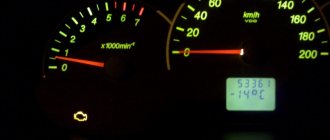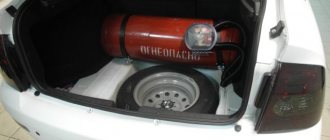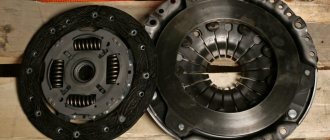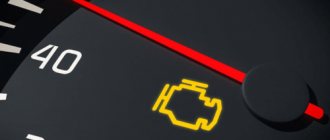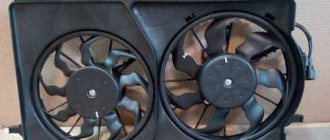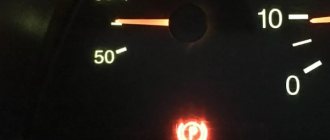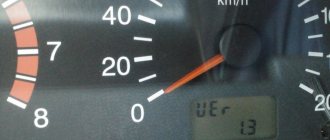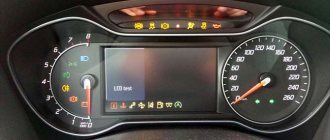If the check light comes on and does not go out on the Priora instrument panel, this means that some part of the engine is faulty. Since after turning on the ignition, all the lights should light up and go out. Because the car systems are tested at this moment for serviceability. However, if one light does not go out, a problem may arise that will lead to breakdown of the VAZ2115 engine or automatic transmission, or some other life support system of the vehicle.
What is a check engine?
“Check Engine” is translated from English as “Check the engine.” On different cars, on the dashboard there is either such an inscription, or simply “Check”, or an engine icon. On the Priora, it is the yellow icon that lights up, resembling an engine in shape. “Check” lights up in two cases:
- Checking the functionality of the sensors. When you turn on the ignition, all the icons on the dashboard light up, indicating that there is a signal from the ECU and the system is ready to operate. After 2-3 seconds of turning on the ignition, the icon will go out.
- Malfunction of the engine operating system. There are several important aspects. Firstly, the ECU does not receive data about all breakdowns: it cannot technically record any mechanical damage. Secondly, the appearance of this icon may be erroneous. But you shouldn’t trust the opinion “it’s all for nothing” - a problem with the engine can grow like a snowball and cost a pretty penny if you ignore it. Regardless of whether the “check” on the Priora is on or flashing, the problem needs to be solved.
If the check light comes on when starting on a cold engine
The “Check Engine” light on a Priora translated from English means checking the engine. However, on modern vehicles such as Mercedes and BMW, there is an automatic check of all systems and errors are displayed on the control panel screen, but on the Lada there is no such thing.
This icon lights up or blinks due to the following problems:
- some sensor, for example, oxygen, has failed;
- the light flashes when the spark plugs fail to operate;
- the injectors are clogged or the fuel pump is broken.
All these problems must be found and solved as quickly as possible so as not to lead to a major overhaul of the engine. Therefore, when a flashing light appears on the Priora check engine, you need to contact the service center and see experienced mechanics. Some will diagnose the problem and cure it.
In some cases, a small mobile device will help. It will help you see the problem in the garage, then you can look up the solution on the Internet.
Attention! If the car owner does not understand the design of the engine at all, then diagnosing it with his own hands will not help. It is better to leave it to experienced mechanics.
Priora: why the check is blinking or on - the main reasons
The diagnostic connector will help you “talk” to the electronic control unit and find out why the check light is on. Well, before you start diagnosing, check out the list of the most common Priora “errors”:
- Low Oil Level – Low oil levels ultimately lead to increased engine wear. If the oil level turns out to be normal when checked, then it needs to be replaced and the integrity of all Priora components checked. Faulty fuel pump or fuel filter. You can’t always “hear” this, but diagnostics, replacing the filter, and checking the fuel pump will “cure” the breakdown.
- An error in the operation of the exhaust gas system - this is not something to joke about - it is better to start repairs as soon as possible.
- The ignition coil does not produce a spark / the catalytic converter is unstable.
- Wiring problems - high voltage wires can give an erroneous signal to the ECU - "Check" will light up on the dashboard.
- Malfunction of sensors - unfortunately, they very often fail. The “check” lights up due to the fault of the mass air flow sensor (MAF), two oxygen sensors (after the fuel afterburner and in the exhaust manifold), the crankshaft sensor and the camshaft sensor. In frosty weather, the “Check” may light up because three cylinders are turned on first, and then, during normal startup, it does not go away. This is due to the fact that soot particles remain on the contacts - they disappear after a few days.
- False sensor activation due to high humidity
- The engine starts running when cold and the check light comes on.
The reasons for the “Check” fire on a Priora (16 valves), as we see from the list, can be serious. There is no need to panic: when the “Check” light comes on, you need to immediately reach for the diagnostic connector. It’s funny, but earlier diagnostics were carried out in the service with special software, but today any error code can be displayed on your smartphone, deciphering it using a mobile reading device.
There is another reason for engine malfunction - low-quality gasoline.
If this causes the spark plugs to flood, you will see the “check” blinking. Low-quality gasoline can be sold at any gas station; experienced car enthusiasts advise carrying a couple of candles with them. Sometimes the “Check” light comes on due to gasoline and the engine stalls. If he continues to work intermittently, things will be bad.
What is Check Engine?
This unexpected and unpleasant combination of words for a car enthusiast that lights up on the instrument panel literally translates as “check the engine.” The designation implies the presence of sensors and systems that monitor the state of the power unit and notify the on-board computer about this. After starting the engine, this indicator should go out in operating condition.
What does the Check Engine light mean?
To start the engine, the driver turns on the ignition. If the check engine light is flashing at the same time, this should not cause concern, since it will soon go out. But a burning signal while the engine is running indicates problems with its operation.
If a malfunction occurs in the operation of the power unit, an error is recorded in the memory of the control unit in the form of a coded signal. In this case, the check engine light appears on the dashboard. If the car does not have diagnostics in automatic mode, you need to connect a scanning device to a special connector. The scanner reads the code and provides a detailed explanation of the error.
With the development of electronics, the Check Engine indicator has evolved from a simple fault sensor into a warning lamp with many functions. When a modern check engine light flashes, it reports the following inconsistencies:
- incorrect composition of fuel mixtures;
- settings failures in the ignition system;
- sensor failures.
His duties also include reporting problems not related to the power unit. To identify the location and nature of the breakdown, the technician will need professional knowledge, experience, special devices and tools.
Important: The ECU electronic unit commands the indicator to flash as a result of detecting errors of varying degrees of complexity. Among them there are problems both serious and minor. In order to carry out diagnostics, it is recommended to suspend operation of the vehicle. Experienced car owners often independently determine the reason for the inclusion of a check, without waiting for a visit to the service station.
Purpose of the Check Engine Warning Alarm
When the Check Engine warning light appears, it indicates an engine malfunction; in such a case, driving the vehicle is not recommended. The driver should turn off the engine and take the car to a service center using a tow truck. The problem is that when such an alarm lights up, a message about a specific breakdown is not displayed. As a result, you have to carry out a complete diagnostic of the engine, often this is an expensive job, and it is not always possible to determine existing problems in the engine even on a special computer.
How to reset "Check Engine" on Priora
If the check light is on, then there are two solutions to the problem: fix it, or reset it. The engine icon that lights up is evidence that the ECU has received information about some kind of malfunction in the engine and is informing the driver about it. All errors remain in the computer's memory, so in order to get rid of them without repair, they need to be reset or erased. You can reset a check by following these steps:
- Turn off the engine, secure the car, and open the hood;
- Find the fuse box, in the yellow group, remove F1 (30 Amperes) and wait about 20-30 seconds;
- Put the fuse back and close the hood. Start the engine and check if the signal disappears.
the Lada Priora engine troit?
8 and 16 valves and what to do
Lada Priora
- a favorite among Russian cars, sales of modern vehicles are breaking records. Among the advantages of the Priora, owners note a good engine, which, in comparison with other Lada models, has the best dynamics; the interior is also very comfortable. But it doesn’t happen without effort, for example, an engine designed for 8 or 16 valves often fails.
A malfunction results in the motor quickly overheating, working as hard as it can, and then burning out a little later. Newbies are interested in what it means to “trouble” the engine? Experts explain that when you start the engine, it runs intermittently, and dull sounds are clearly audible from the exhaust pipe. Unburnt fuel emits a strong, stuffy odor, vibrations increase over time, and cracks form in the cushions.
See:
Ignition system
An experienced car enthusiast who is faced with an engine running on three cylinders immediately begins to diagnose the spark plugs. The Lada Priora must cool well, otherwise there is a risk of getting burned when unscrewing it. If after a few seconds you turn off the ignition and check the spark plugs, one of them will be wet with gasoline. It is also recommended to separately check each part for the presence of a spark.
In case of malfunction, the problem is solved by replacing the spark plug. Sometimes it is enough to press down a potentially faulty one with a cap and the machine will resume normal operation. In general, the ignition system in this car is the most problematic part. If the Priora engine (16 valves) is malfunctioning, you can look for the reasons for a very long time, and diagnostics will not yield anything, even if it is done correctly. And only by replacing all elements can a positive result be achieved.
What is the danger when the engine stalls?
The first obstacles, now you understand, begin when you try to start the car. The Priora cannot be accelerated at all with the engine running like this, because in due course of acceleration the vibrations become even stronger. There is no need to experiment with overtaking on the road if you are driving the car when the engine is shaking - at that time the engine power decreases sharply, which means that there is a possibility of a lack of dynamics to successfully complete the maneuver.
The Priora has been in production since 2007, which is why in some cars the engine rattles as if it were already a quarter of a century old. This is how a 3-cylinder engine works. Even if the latest firmware is installed, a faulty engine will cause the check to glow. This is fraught with a reduction in the service life of the car.
What is the danger of this defect?
Having discovered that the engine begins to stall, this defect must be eliminated as quickly as possible, despite the fact that signs of malfunction may disappear after re-gassing. The fact is that such a malfunction can reduce engine power, which will lead to an emergency on the road. After all, every car owner relies on the power of his engine, especially when overtaking, and since the power of the power unit will be reduced, the car simply will not have enough dynamics to complete overtaking, especially in severe frost and ice on the road. Only timely car repairs and finding out the cause of the breakdown will help to avoid a deplorable situation.
Every car owner can do this in his own garage with the simplest tools, if the work is done in stages.
Why is the check engine blinking and the engine shaking? The car began to slow down.
Engine damaged
,
the check
, the engine does not pull, it jerks. I turn off the ignition. , I start it again and it’s fine.
- There is no flash in the cylinder - check if there is fuel. At a normal compression level, you need to test the operation of the accounting power system. Focus on the air filter and pipe: are the clamps tightened tightly, what is the condition of the purifier box, is the air intake from outside adjusted. The tubes located on the throttle assembly are made to be firmly fixed to it. Traces of fuel leaks, visible cracks and chipped plastic are unacceptable.
- The engine may stall
due to a clogged injector. For this reason, specialists categorically do not accept filling the tank with cleaners sold for injectors. In fact, no cleaning occurs - the contaminants peel off in the tank, and then the fuel line becomes clogged. There is a build-up in the small nozzle and it will get stuck. - The winding of the injector parts burned out.
- Low quality fuel.
- Test the spark plugs.
Checking the ignition coil
There is simply no special method by which you can check the operation of parts. The instructions for the car indicate one of the methods for self-diagnosis. So, with the ignition turned off, check whether the ignition coil (Priora is no exception) is firmly attached to the engine.
Then they look at the reliability of electrical connections in the low-voltage circuit. If everything is in order, then check for a spark. To do this, the ignition coil is removed. A test plug is inserted into the tip and pressed against a metal part of the engine. Next, turn the starter. If there is no spark, replace the coil. If there is a flash, but the engine does not start, change the spark plug.
What to do when the Lada Priora engine troits
Lada Priora engine repair
in artisanal conditions it depends on the cause of the malfunction:
- If the combustion of the windings of the injector parts is to blame, remove the cover, and then remove the manifold. Assess the condition of the windings and measure the resistance using a multimeter. The best resistance level is from 11 to 15 ohms. At the lowest level of values, the winding must be replaced.
- If the resistance indicates normal characteristics, remove the fuel rail and thoroughly wash each part with water. However, it is harmful to take on a deficiency in this category if you do not have the ability to repair it - be as careful as possible. For flushing to be successful, open the valves suitable for the nozzle, and then apply an aerosol-type flush under pressure.
- If you have doubts about fuel, completely drain the old one and fill the engine with 8 or 16 valves of 95 gasoline. A high octane number is not advisable; on the contrary, this option may lead to overheating of the engine. If changing gasoline does not help, then change the air and fuel filter units.
- How to check if a spark plug is working properly? It’s actually simple - let the car cool down well, otherwise, when you start unscrewing the elements, you can get a severe burn. After switching off, after just a little ignition, the faulty spark plug will be moistened with gasoline. Also see if the candle can create a spark.
If it is impossible to repair the spark plug so that the engine stops firing , it is completely replaced, and it is not at all necessary to go to 100. Armed with a 10-12 key, turn off the elements responsible for the ignition. Then carefully clean the spark plug from dust, otherwise debris may get into the Lada Priora
.
A tire compressor is suitable for this procedure; in the latter case, a brush. Then remove the spark plug with a spark plug wrench, where the head with the gasket is certainly fixed. New devices are installed with the same screwing.
There is a special offer on our website. It is possible to get a free consultation with our corporate lawyer by simply asking your own question in the form below.
Reasons why the engine “troubles”
The engine may throb constantly or from time to time. General signs of engine vibration are as follows: at idle speed, strong uneven vibrations begin to penetrate from the engine compartment into the cabin, the sound of the running engine changes (it “growls”, goes from high “notes” to low ones, and back).
Error code: Diagnostic truck scanner buy :: Price of truck scanners
The unit begins to consume more fuel, and its power decreases, and obscene sounds are heard from the exhaust pipe, accompanied by thick white or black smoke. If at least one of these signs is present, it means that the “heart” of your car has problems with one or more cylinders.
If they are not eliminated in time, the consequences can be very disastrous - up to and including a major overhaul of the power unit.
internal combustion engine
Let's characterize the most common reasons why an engine stalls - there are four of them:
- late or early ignition of the air-fuel mixture (FA);
- uneven entry of fuel into the engine cylinder;
- lack or excess of air in the combustion chamber of the cylinder;
- drop in compression level.
Let's take a closer look at them.
. If the air-fuel mixture ignites in the cylinder earlier or later than the specified period, then the spark plugs are to blame, which produce too weak a spark, or the formation of a spark occurs untimely. Weak sparking occurs due to the fact that harmful deposits (carbon deposits) accumulate on the spark plug body and its electrodes, which interfere with spark breakdown.
carbon deposits on candles
Another reason for a weak spark is the destruction of its insulator. In the place where the insulator has collapsed, a soot spot forms, which prevents the formation of a normal spark.
If there is no spark at all, then there may be several reasons: a worn spark plug cap, a failed high-voltage wire (supplies current to the spark plug), a breakdown of the ignition coils or switch.
The latter phenomenon is quite rare, but it would not be superfluous to check the condition of the switch, which controls the ignition distribution.
. Uneven entry of fuel into the cylinder, when a smaller amount of gasoline or diesel is poured into the combustion chamber, often occurs due to a malfunction of the fuel pump parts (pressure part or pressure reducing valve) or the pressure valve in the fuel supply system.
If more fuel than necessary gets into the cylinder, the problem probably lies in the fuel injectors - they are dirty or out of order.
Finally, another “fuel” reason for engine throttling is a malfunction of the electronic control unit (ECU) of the power unit, which can erroneously increase or decrease the supply of gasoline/diesel to the cylinder.
. Excess air in the cylinder is a sign of depressurization of the air supply system, which includes the air filter, intake pipe hose, throttle pipe and receiver. A lack of this important component of the air-fuel mixture in the cylinder can be caused by a dirty air filter or broken throttle valves.
air filter clogged
A malfunction of the mass air flow sensor or throttle position sensor, which the ECU perceives as a request from the engine to add or reduce the amount of air into the combustion chamber, can also cause the engine to trip.
. Low compression or its complete absence is perhaps the most serious reason why an engine misfires. This is the first sign that the pistons or valve in an idle cylinder are burnt out, or the piston rings are completely worn out.
This cannot be done without serious repairs to the power unit. In addition to the common reasons why an engine misfires, there are also secondary ones. They are spoken of when the engine starts to run periodically - “cold” (at idle speed) or “hot” (at medium or high speed).
The most common malfunction here is the valves: when their gap increases at idle speed, the engine trips, which goes away as it warms up (the gap is restored).
And vice versa, the gap increases when the engine reaches operating temperatures - that’s when it starts “hot” with all the signs described above.
